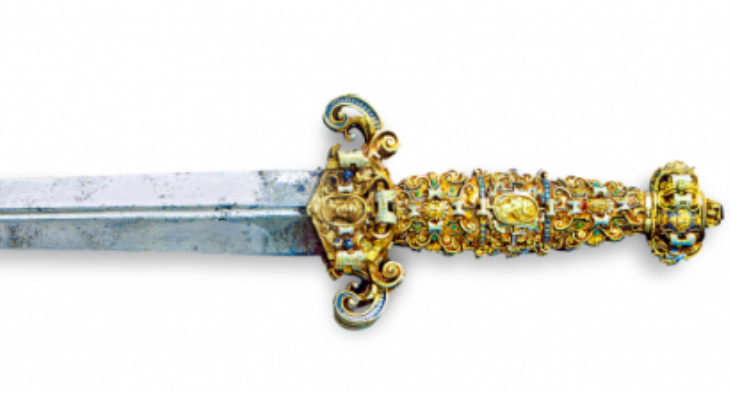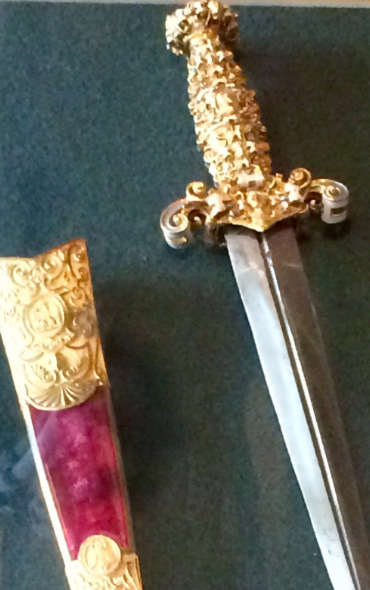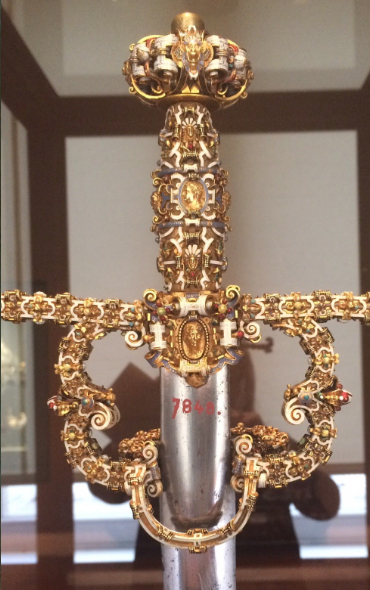Lost (& found) Maltese treasures: the sword & dagger of Grandmaster de la Valette
When even Malta’s capital city bears his name, it’s not surprising that the Maltese would make a treasure of anything that ever had a connection with Grandmaster de la Valette (1557-68).

Daniel Cilia
Allegedly used during the Great Siege of 1565, some such treasures include three pieces of armour (the breastplate, backplate and falling buffe) held in the Palace Armoury in Valletta and the Grand Master’s actual fighting sword used during the Great Siege, which is held at the chapel of Our Lady of Damascus within the Oratory of St Joseph at Vittoriosa.
Oh, and last but not least, we also have Grandmaster’s de la Valette’s fabric wide-brimmed sun hat, probably worn while scrutinising the enemy situation on Mount Sceberras across the water from Vittoriosa.

Simone Cummings
De la Valette’s armour and fighting sword were reunited in 2017, the same year when his ceremonial dagger was on display in Malta on loan from the Louvre for the first time since 1798.
Indeed, Napoleon’s army had pilfered much of Malta’s treasures. The clever Maltese set about painting their precious gold - often found in their churches - black, to stop them being stolen, but the Grandmaster’s ceremonial sword and dagger had already been taken, never to return ‘home’ until almost 220 years later.
The ornamental sword and dagger, originally belonging to King Philip II of Spain, were gifted to the Grandmaster in recognition of de la Valette’s illustrious victory over the Ottomans and Suleiman the Magnificent during the Great Siege of 1565 - a siege that could have forever altered the course of Europe’s entire religious tradition and culture.
The sword and the dagger together make one set. The dagger, a poniard, was a parrying weapon used in conjunction with the sword, a mid-16th century rapier with a rich and elaborate hilt. The dagger is fashioned with a well-sized cross guard and side rings. It is decorated similarly to the sword, with cast and chiselled gold decorations highlighted with turquoise, blue, black, red and white enamel. Unfortunately, the original gold decorated girdle and sheath are long lost.
The sword and dagger were bequeathed to the Sovereign Order of the Knights of Malta upon the death of Grandmaster de la Valette. The sword and dagger were precious and iconic items in the Order’s treasury that were annually paraded during the 8th September festivities for two centuries, until 1797.

Simone Cummings
When Napoleon’s forces invaded Malta in 1798, the French took both items. The sword somehow found its way to Paris but Napoleon Bonaparte apparently took the dagger as a talisman and carried it with him. The dagger passed on to his son, upon Napoleon’s death in 1821, and it was eventually presented to the Louvre in 1840 where it was first displayed in 1852.
Both items never left Paris for centuries after. But, interestingly, nobody in Paris really offered these historic items the prestige they deserve. If you had gone to the Louvre prior to 2017 - and searched for these treasures among the tens of thousands of exhibits - you would have been hard-pressed to find them, unless you knew where to look. They were kept in the Richelieu Wing, Floor 1, Louis VIX section: Objects d’Art – Decorative Arts, Room 25, yet the Louvre website returned no results for searches for ‘Valette’, ‘dagger’, ‘sword’ or ‘Pery Juan Poch’, the Spanish artist who made them, while guides at the famous palace just returned blank faces.
Thankfully, with Valletta being the European Capital of Culture 2018, the dagger and sword returned to a place where they could be properly appreciated: Malta, home of the Order of St John prior to Napoleon’s invasion.
In actual fact, the sword and dagger never belonged to the Maltese. But Malta was the home of the Order of St John, and these were prized possessions of the Order after they ceased to be the personal possessions of Grandmaster de la Valette. Although the Treaty of Vienna of 1815 decreed that the French should return all items looted during the Napoleonic Wars, there was disarray in the Order of St John at the time and no claim was ever made by the Order.
Although both pieces were to be loaned (alas not returned!) to Malta by the Louvre Museum when Valletta took the title of European Capital of Culture in 2018, it turned out that the sword was “too fragile to be transported”. In the end, only the dagger and Valette’s own fighting sword, along with his armour and, um, sun hat were on display at the Museum of Archaeology in Valletta.